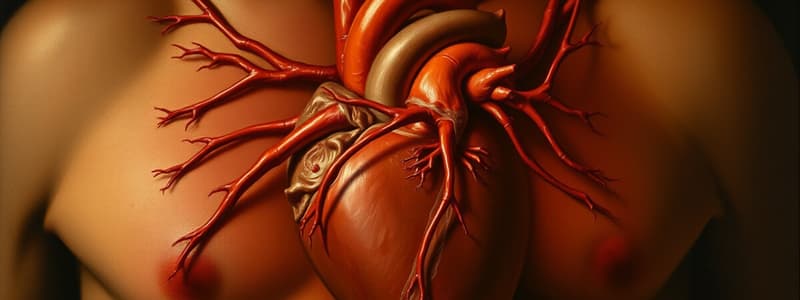Podcast
Questions and Answers
What is the primary structural role of the atrium in the heart?
What is the primary structural role of the atrium in the heart?
- To regulate respiratory functions in the body
- To oxygenate blood before sending it to the body
- To pump blood out of the heart to the body
- To receive blood from veins and pump it into the ventricles (correct)
Which statement best describes the function of the right atrium?
Which statement best describes the function of the right atrium?
- It prevents backflow during ventricular contraction
- It initiates electrical impulses for heartbeats
- It receives deoxygenated blood from the body (correct)
- It receives oxygenated blood from the lungs
How do the atria contribute to pressure regulation within the heart?
How do the atria contribute to pressure regulation within the heart?
- By directly regulating heart rate through nervous input
- By acting as valves during diastole
- By pumping blood out to the lungs
- By accommodating varying blood volumes before ventricular contraction (correct)
What is the role of the atrioventricular (AV) valves in relation to the atria?
What is the role of the atrioventricular (AV) valves in relation to the atria?
What condition can atrial enlargement or dysfunction indicate?
What condition can atrial enlargement or dysfunction indicate?
Flashcards are hidden until you start studying
Study Notes
Function of Atriums
-
Structural Role:
- The atrium is a chamber of the heart that receives blood from veins and pumps it into the ventricles.
-
Oxygen-Rich and Oxygen-Poor Blood:
- The right atrium receives deoxygenated blood from the body via the superior and inferior vena cavae.
- The left atrium receives oxygenated blood from the lungs through the pulmonary veins.
-
Pressure Regulation:
- The atria help to regulate pressure within the heart, accommodating varying blood volumes before the ventricles contract.
-
Blood Flow Facilitation:
- Atria act as reservoirs, allowing blood to flow smoothly and continuously into the ventricles during the filling phase.
-
Conduction System:
- The right atrium houses the sinoatrial (SA) node, which acts as the heart’s natural pacemaker, initiating electrical impulses for heartbeats.
-
Preventing Backflow:
- Atrioventricular (AV) valves (tricuspid and mitral) prevent backflow of blood from ventricles to atria during ventricular contraction.
-
Atrial Contraction:
- Atrial systole (contraction) helps to push the last portion of blood into the ventricles, optimizing filling before ventricles contract.
-
Pathophysiological Role:
- Atrial enlargement or dysfunction can be indicators of various cardiovascular conditions, such as atrial fibrillation or heart failure.
-
Blood Volume Sensing:
- Atria contain stretch receptors that play a role in regulating blood volume and pressure, influencing fluid balance and kidney function.
Function of Atriums
- Atria are heart chambers that receive blood from veins and channel it into the ventricles.
- Right atrium collects deoxygenated blood from the body via superior and inferior vena cavae.
- Left atrium receives oxygenated blood from the lungs through pulmonary veins.
- Atria assist in regulating heart pressure, accommodating fluctuations in blood volume prior to ventricular contraction.
- Atria serve as reservoirs, ensuring uninterrupted blood flow into the ventricles during the filling phase.
- Sinoatrial (SA) node, located in the right atrium, functions as the heart's natural pacemaker, generating electrical impulses for heartbeat initiation.
- Atrioventricular (AV) valves, namely the tricuspid and mitral valves, prevent blood from flowing back into the atria during ventricular contraction.
- Atrial contraction (atrial systole) aids in pushing the final volume of blood into the ventricles, enhancing filling efficiency before ventricular contraction.
- Atrial enlargement or dysfunction may signal cardiovascular issues, including atrial fibrillation or heart failure.
- Atria possess stretch receptors important for sensing blood volume and pressure, contributing to fluid balance and kidney function.
Studying That Suits You
Use AI to generate personalized quizzes and flashcards to suit your learning preferences.




